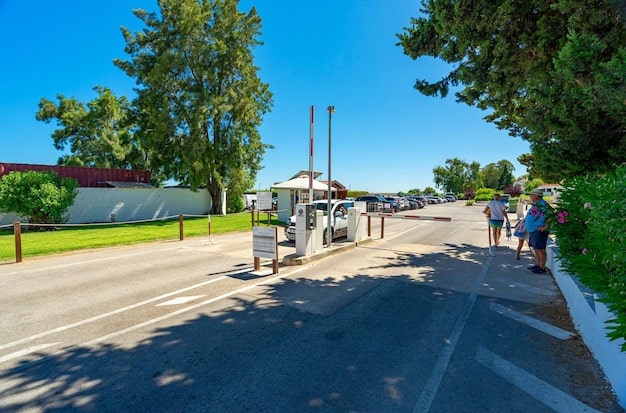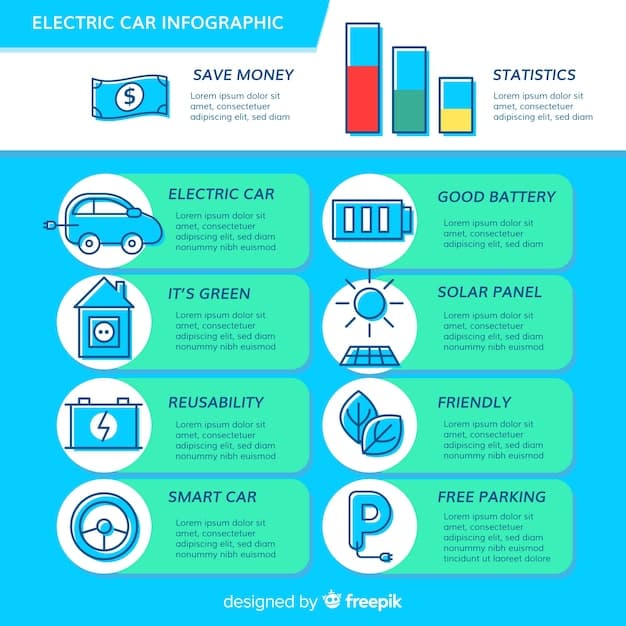Electric Vehicle Infrastructure Bill: $7.5B for Charging Stations

The Electric Vehicle Infrastructure Bill allocates $7.5 billion to expand the electric vehicle charging station network across the United States, aiming to accelerate EV adoption and reduce range anxiety.
The Electric Vehicle Infrastructure Bill Update: $7.5 Billion Investment in Electric Vehicle Charging Stations – Where Will the Money Go? That’s the question on everyone’s mind as the US government aims to boost EV adoption through strategic infrastructure development.
Electric Vehicle Infrastructure Bill: An Overview
The Electric Vehicle Infrastructure Bill, a key component of the Bipartisan Infrastructure Law, represents a significant investment in the nation’s electric vehicle (EV) ecosystem. This legislation has earmarked a substantial sum of money to promote the expansion of EV charging infrastructure.
It is designed to overcome barriers to EV adoption, such as concerns about range anxiety and the availability of convenient charging locations.
Goals of the Infrastructure Bill
The primary goal is to establish a nationwide network of EV chargers, making it easier for people to switch to electric vehicles. Here are the main objectives:
- Facilitate widespread EV adoption by addressing charging infrastructure gaps.
- Reduce greenhouse gas emissions from the transportation sector.
- Support economic growth by creating jobs in EV infrastructure development and maintenance.
By strategically deploying charging stations across the country, the bill aims to alleviate range anxiety and make EVs a more viable option for a broader range of consumers.
In essence, the EV Infrastructure Bill lays the foundation for a future where electric vehicles are not just a niche market but a mainstream mode of transportation. The investment seeks to facilitate this transition by modernizing and expanding the charging infrastructure to support both current and future EV owners.
How the $7.5 Billion Will Be Allocated
The $7.5 billion allocated by the Electric Vehicle Infrastructure Bill is not a lump sum to be spent indiscriminately. Instead, it follows a comprehensive allocation strategy.
A portion of the funds is set aside for specific programs, while the rest is distributed to states based on approved plans.

The NEVI Formula Program
The National Electric Vehicle Infrastructure (NEVI) Formula Program is a core element of the bill. It provides funding to states to deploy EV chargers along designated Alternative Fuel Corridors.
These corridors are major highways and interstates identified as suitable for EV travel. NEVI funds facilitate the construction of reliable and accessible charging stations every 50 miles along these routes.
- States must submit plans detailing how they intend to use the funds.
- The federal government reviews and approves these plans to ensure alignment with national goals.
- Funds cover the costs of charger installation, operation, and maintenance.
This program aims to establish a minimum standard for EV charging infrastructure across the country, ensuring that EV drivers have access to reliable charging points along the most frequently traveled routes. By following a formula-based approach, the NEVI program strives for equitable distribution of funds among states, taking into account factors such as population and transportation needs.
The NEVI formula program is pivotal in creating an ecosystem where EV drivers can traverse long distances without the worry of running out of power or being stranded without charging facilities. This investment is set to transform the landscape of electric mobility in the US, fostering both economic and environmental gains.
State-Level Initiatives and Plans
Each state plays a critical role in the implementation of the Electric Vehicle Infrastructure Bill. States are responsible for developing and executing plans specific to their local needs and priorities.
These plans must align with federal guidelines and contribute to the overall goal of establishing a robust nationwide charging network.
Planning and Implementation
States are required to submit detailed plans outlining how they will use the NEVI funds. These plans must include:
- Specific locations for new charging stations.
- Timelines for project completion.
- Strategies for ensuring charger reliability and accessibility.
Successful implementation also requires collaboration among various stakeholders, including state transportation agencies, utility companies, and private businesses.
Several states have already made significant progress in developing and implementing their EV infrastructure plans. California, for instance, is focusing on expanding charging access in disadvantaged communities. New York is prioritizing high-speed charging along major transportation corridors. Texas aims to create a comprehensive charging network throughout the state, connecting urban and rural areas.
States may consider regional variations, such as climate-specific charging needs in colder areas or meeting the transportation needs of geographically isolated communities. Flexibility and tailoring plans to the unique features of each state is important for a successfully deployed EV infrastructure.
Focus on Rural and Underserved Areas
Addressing charging infrastructure gaps in rural and underserved areas is a critical aspect of the Electric Vehicle Infrastructure Bill.
These areas often lack the resources and incentives to attract private investment in EV charging.

Ensuring Equitable Access
The bill allocates funds specifically for projects that benefit rural and underserved communities. This includes:
- Incentives for installing chargers in areas with limited access to charging.
- Grants for community-based organizations to develop and operate charging stations.
- Support for workforce development programs that train local residents to install and maintain EV chargers.
Strategies for expanding EV charging in rural areas include leveraging existing infrastructure, such as public libraries and community centers, to host charging stations. Partnerships with local businesses can also help drive traffic to these locations and make charging more convenient for residents. Additionally, engaging with community leaders and residents can help ensure that charging infrastructure is tailored to the specific needs of the community.
This focus ensures that the transition to electric vehicles is inclusive and benefits all segments of society. The investment in these communities helps tackle range anxiety and guarantees equitable access for people, regardless of where they live.
By providing these resources, the bill aims to ensure that the benefits of electric vehicles are accessible to all Americans, regardless of their geographic location or socioeconomic status.
Challenges and Potential Roadblocks
While the Electric Vehicle Infrastructure Bill represents a significant step forward, challenges and potential roadblocks could hinder its successful implementation.
Addressing these issues proactively is essential to ensure the timely and effective deployment of EV charging infrastructure.
Navigating the Hurdles
Some of the key challenges include:
- Supply chain constraints that could delay the production and delivery of EV chargers.
- Workforce shortages that could make it difficult to find qualified technicians to install and maintain charging stations.
- Permitting and regulatory hurdles that could slow down the approval and construction of new charging sites.
The industry needs to address challenges such as standardizing charging technologies, enhancing grid resilience, and lowering charging costs to make EV adoption more appealing to consumers. Coordination among stakeholders, including government agencies, utility companies, and private businesses, is critical in addressing these challenges.
Overcoming these challenges requires proactive planning, effective communication, and collaboration among stakeholders. By addressing these potential roadblocks head-on, the industry can ensure that the Electric Vehicle Infrastructure Bill delivers on its promise of a cleaner, more sustainable transportation future.
In addition, clear and consistent messaging is needed to educate consumers about the benefits of EVs and the availability of charging infrastructure.
Future Outlook and Long-Term Impact
The Electric Vehicle Infrastructure Bill is expected to have a transformative impact on the nation’s transportation landscape.
By accelerating the adoption of electric vehicles and reducing greenhouse gas emissions from the transportation sector, the bill can contribute to a cleaner, more sustainable future.
Transforming Transportation
Long-term benefits of the EV Infrastructure Bill include:
- A significant reduction in greenhouse gas emissions from the transportation sector.
- Improved air quality in urban areas, leading to better public health outcomes.
- Greater energy independence by reducing reliance on foreign oil.
The Electric Vehicle Infrastructure Bill is designed to create a network of access points in rural and urban regions, contributing to decreased greenhouse gas emissions. A greener footprint and a reduction in energy reliance are anticipated, fostering innovation in EV technology and strengthening the economy.
As the EV charging network expands, the bill can also drive innovation in the EV industry, leading to the development of new and improved charging technologies. This, in turn, can further accelerate EV adoption and create new economic opportunities.
Ultimately, the Electric Vehicle Infrastructure Bill represents a major investment in the nation’s future. By creating a robust and reliable EV charging network, the bill can pave the way for a cleaner, more sustainable, and more prosperous America.
| Key Point | Brief Description |
|---|---|
| 💰 $7.5 Billion Investment | Funds to expand EV charging infrastructure across the US. |
| 🛣️ NEVI Program | States deploy chargers along Alternative Fuel Corridors. |
| 📍 Rural Focus | Ensuring equitable access to charging in underserved areas. |
| ⚡ Future Impact | Reducing emissions, improving air quality, and greater energy independence. |
FAQ Section
▼
The main goal is to accelerate electric vehicle adoption by expanding the charging infrastructure across the United States, making EV ownership more convenient and accessible.
▼
The funds will primarily be allocated through the NEVI Formula Program to states for deploying EV chargers along designated Alternative Fuel Corridors, and competitive grants.
▼
The National Electric Vehicle Infrastructure (NEVI) Formula Program provides funding to states to install EV chargers along designated Alternative Fuel Corridors, ensuring reliable charging opportunities.
▼
The bill allocates funds specifically for projects that benefit rural and underserved communities, incentivizing charger installation and supporting community-based organizations.
▼
Challenges include supply chain constraints, workforce shortages, and permitting and regulatory hurdles that could slow down the deployment of new charging stations.
Conclusion
The Electric Vehicle Infrastructure Bill represents a bold commitment to transforming America’s transportation sector. By strategically investing $7.5 billion in EV charging infrastructure, the bill aims to make electric vehicles a practical and accessible option for more Americans. While challenges remain, the long-term benefits of this investment, including reduced emissions, improved air quality, and greater energy independence, are significant and far-reaching.





